Although Bernedoodles have probably turned up accidentally in the past, it’s generally believed that a breeder named Sherry Rupke of Swissridge Kennels is responsible for this adorable breed.
After many months of careful research and planning, Sherry bred the first two Bernedoodles in 2003, crossing a purebred Bernese Mountain Dog with a purebred Standard Poodle. The result was a fantastic mix of the Berner’s calm, affectionate, loyal nature with the Poodle’s natural playfulness, friendliness, and intelligence.
Since then, these dogs have become extremely popular! It isn’t easy to know precisely how many there are, as they are not recognized by the American Kennel Club (AKC) because they are a mixed breed.
The AKC only lists purebred dogs in its list of the top 202 most popular dog breeds. It’s interesting to note that the most popular dog in America is the humble mutt, not a pure breed!
Anyone who has met a Bernedoodle knows just how cuddly and affectionate these teddy bear dogs are. And if you’re thinking of getting one (and who can blame you?), you might be on a quest to find out more about them.
We can help you by providing general breed information, but we mainly focus on coat colors here.
So, without further delay, let’s look at Bernedoodle colors!
*Before this, Sherry bred Goldendoodles and researched the possibility of improving the Bernese Mountain Dog’s short lifespan of between 6 to 8 years.
Bernedoodle Coat Colors
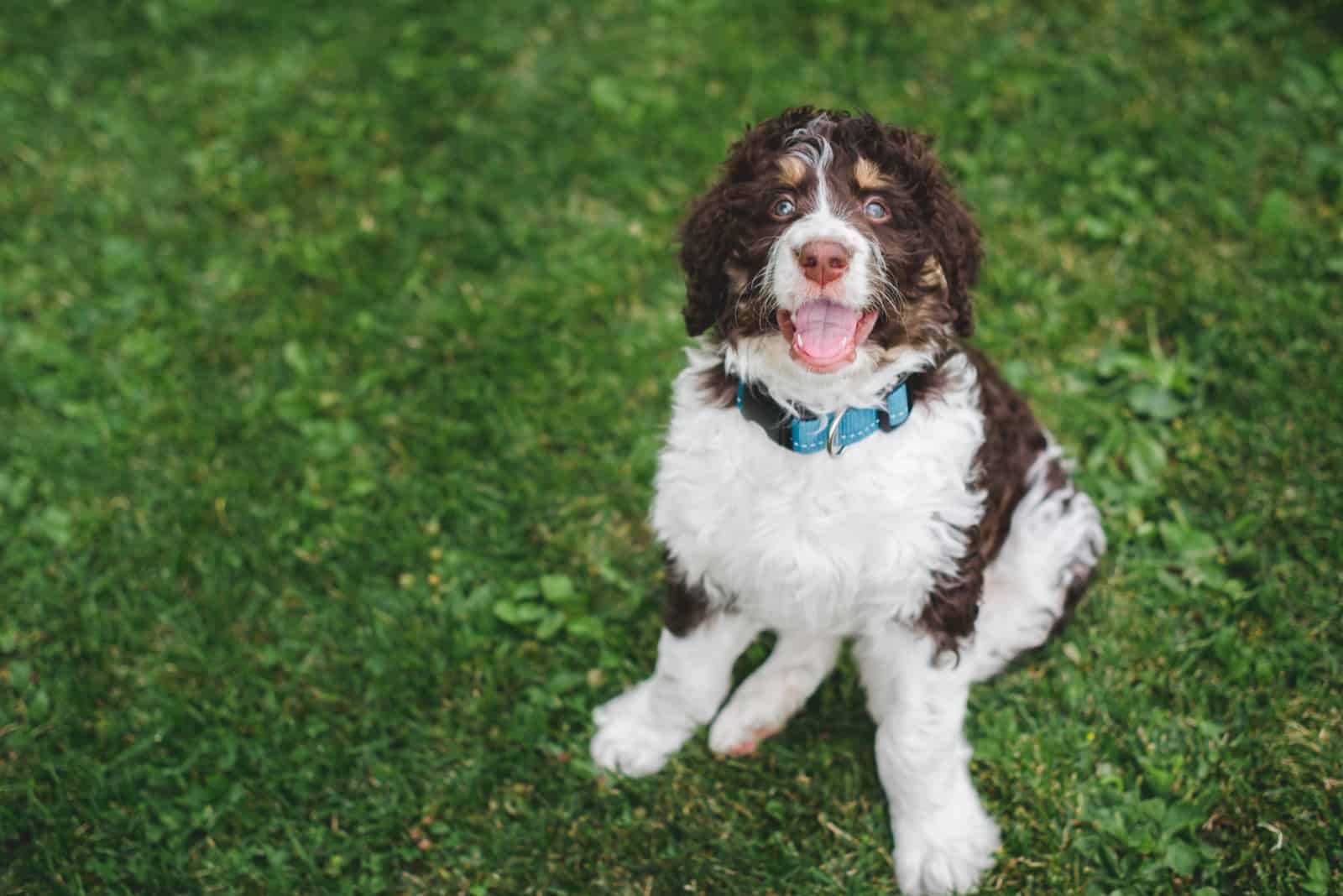
As these dogs aren’t registered with the AKC, there isn’t a breed standard as such. However, they are registered with organizations like the Designer Dogs Kennel Club, so there is some agreement over how the breed should look.
Here’s a quick rundown of some of the Bernedoodle colors you might expect to see:
• Tri-Color
• Black
• White
• Black and brown
• White and brown
• Cream
• Fawn
• Bi-color
• Blue
• Merle
• Sable
• Phantom
• Brindle
• Brown
• Apricot
• Gray
• Black and white
• Red and white
• Parti-colored
Some are patterns rather than colors. Don’t worry if a few of these terms are unfamiliar, as we’ll explain them in a moment.
As you can see, there’s quite a broad range of Bernedoodle colors! Each one has its appeal.
You can find more details on these further along.
Bernedoodle Color Genetics
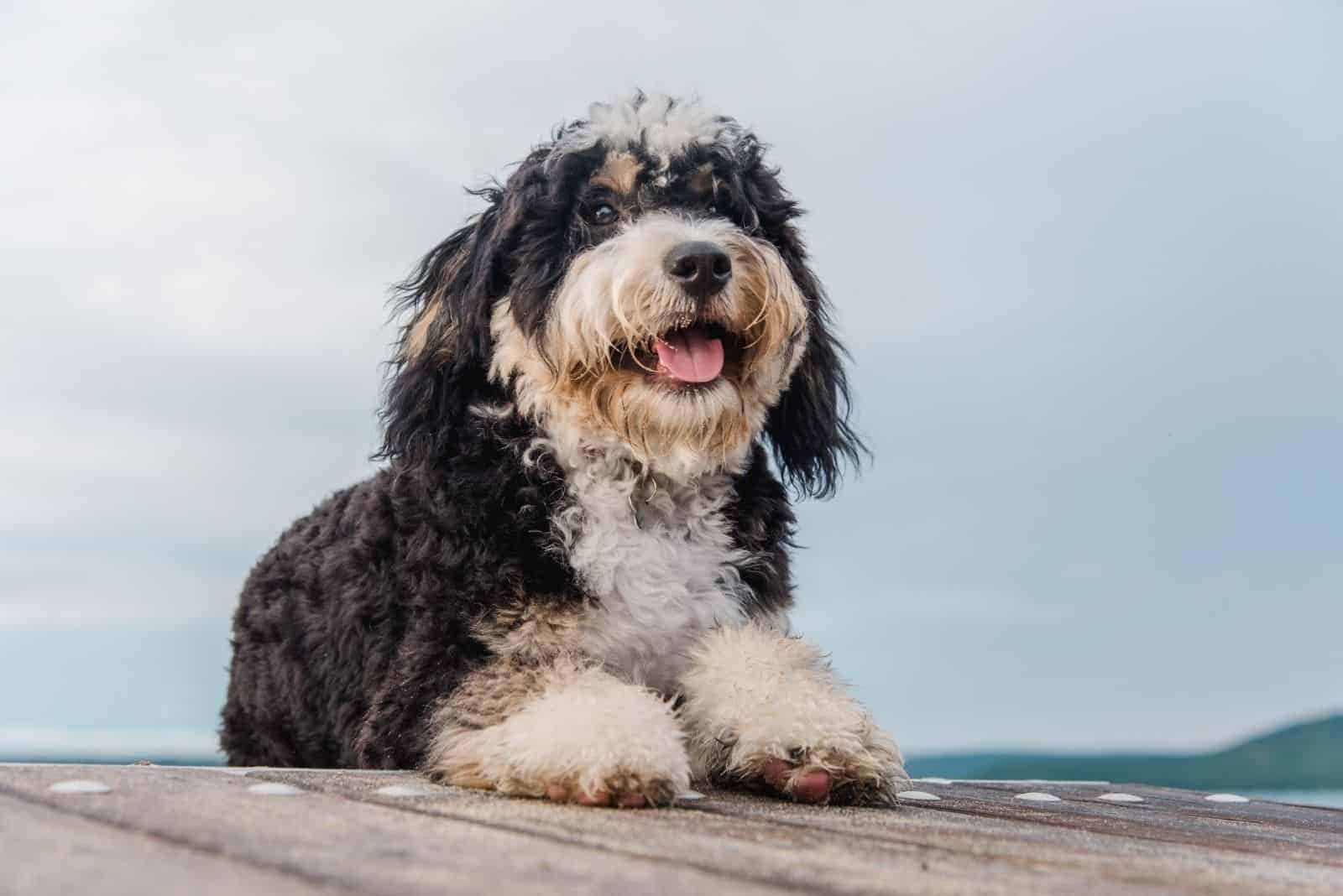
Don’t panic! We won’t delve into the subject of genetics too profoundly.
A dog’s coat color is determined by the genes it inherits from its parents. So far, so good?
These colors are produced by two pigments, eumelanin and pheomelanin. Specific genes interact with these pigments and tell them how much to use, creating different shades, tones, and patterns.
The default color of eumelanin is black, while pheomelanin is red. The genes alter these, producing the vast range of coat colors we see in the Bernedoodle. Black becomes gray, blue, brown, and all shades in between, and red becomes cream, gold, and fawn.
The genes can tell hair follicles not to use any pigment, resulting in white hairs.
It’s worth noting here that eumelanin is also responsible for the color of a dog’s eyes and points (eye rims, lips, nose, and paw pads). While most dogs have brown eyes, some will have amber, blue, or green eyes.
The genes that produce different colors also create the coat patterns mentioned above. They do this by switching the pigment on and off, with the following effects:
• Merle – patches or solid color with an irregular, spotted, mottled pattern.
• Brindle – dark stripes over a lighter base color, sometimes called tiger stripes.
• Sable – hairs are dark at the tip but lighter at the base.
• Phantom – a solid colored base with a second color on the chin, legs, throat, tail, eyebrows, and paws.
• Parti-colored – a 50/50 split between white and another color.
• Tri-color – three randomly placed patches of solid color with no two dogs the same.
On the subject of genetics, you might notice that breeders and some doggy websites sometimes use letters and numbers when referring to particular pups. You’ll see things like f1, f1b, and f2. So, what does this mean? It’s pretty straightforward!
An f1 Bernedoodle is a ‘first generation dog,’ meaning both dog parents are purebred. So, all f1 Bernedoodles are produced by breeding a Poodle and a Bernese Mountain Dog.
As you can probably guess, f1b Bernedoodles are the result of breeding an f1 Bernedoodle with a Poodle or Berner! In most cases, a Poodle is used, creating a mix that is 75% Poodle and 25% Berner.
An f2 Bernedoodle is a 2nd generation cross, meaning two f1’s are bred.
Now you have a better idea of what these terms mean, let’s look at some of the colors in more detail.
Bernedoodle Tri-Color
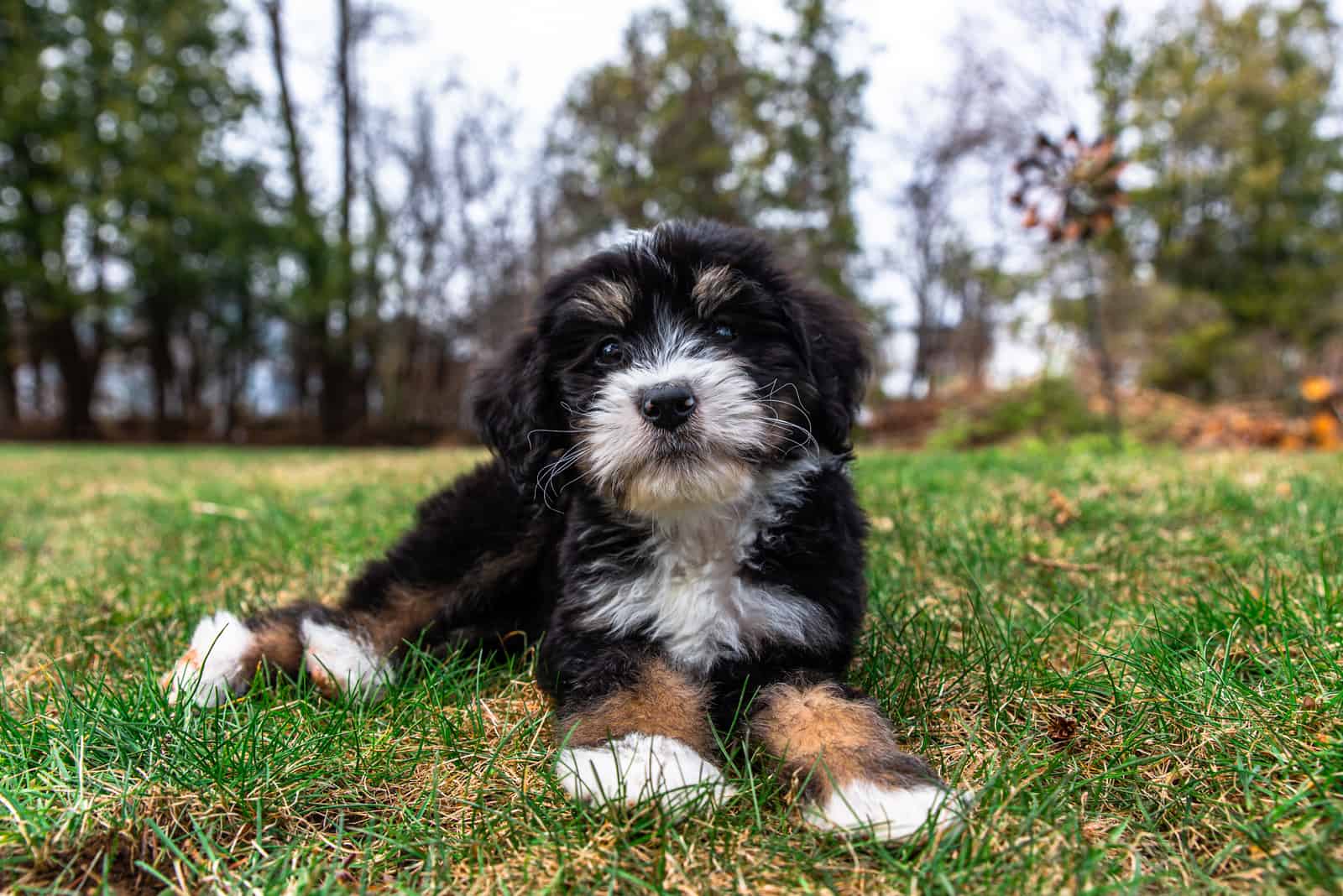
A tri-color Bernedoodle often displays the standard colors of the Bernese Mountain Dog: a black and white coat with red or rust markings. It’s a beautiful color combination on the Berner and even more on the Bernedoodle!
However, tri-color means ‘three colors,’ meaning that this dog can have any three of the following:
• Red
• White
• Brown
• Apricot
• Black
• Cream
• Tan
Most people go for dogs with a tri-colored coat because they look unusual and appealing. The colors appear randomly (usually with white markings on the chest, feet, and muzzle), so you can be sure that your tri-color Bernedoodle puppy will be different from the others.
Phantom Bernedoodle Colors
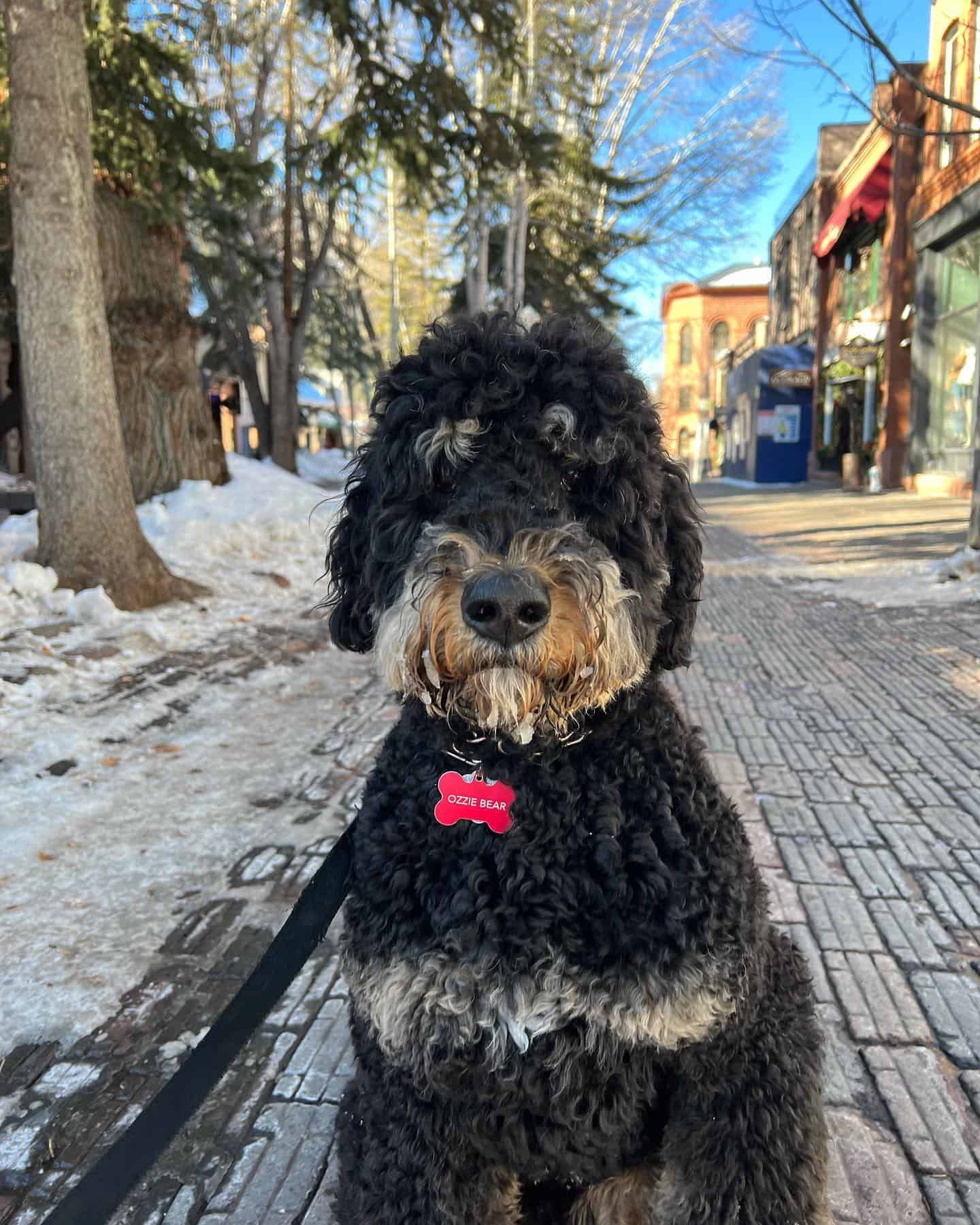
Photo from: ozziebearthebernedoodle
The phantom Bernedoodle is a unique and stunning variation. They differ from the parti-colored dog in that their patches of secondary color aren’t random but appear in specific places on the body.
Phantoms have a fantastic range of color combinations, including:
• Silver and cream
• Black and tan
• Black and cream
Out of these, black and tan (or brown) is the most common phantom color.
In addition to these beautiful Bernedoodle colors, you can also get phantom tri-color, merle, sable, and chocolate!
However, if you were hoping to get one of these fantastic dogs, you’ll need to speak to the breeder as some colors are only available in f1b or f2 pups. It all depends on the breeding program as to which colors are likely to appear.
Sable Bernedoodle

If you remember what we said in the section on coat color genetics, specific genes instruct the cells controlling the pigment to switch on and off. So, these genes might tell the cells to produce black hairs before switching off the pigment or changing to a different color, resulting in solid color hairs with black tips.
Sable works for all colors and patterns, including tri-color, merle, and phantom!
When they’re born, sable pups may look almost entirely black, and they also might resemble the phantom coloring. However, as with most puppies, this vibrant coat will change color as they develop. Color fading is typical in dogs, and you can find out more about this below.
Bernedoodle Color Fading
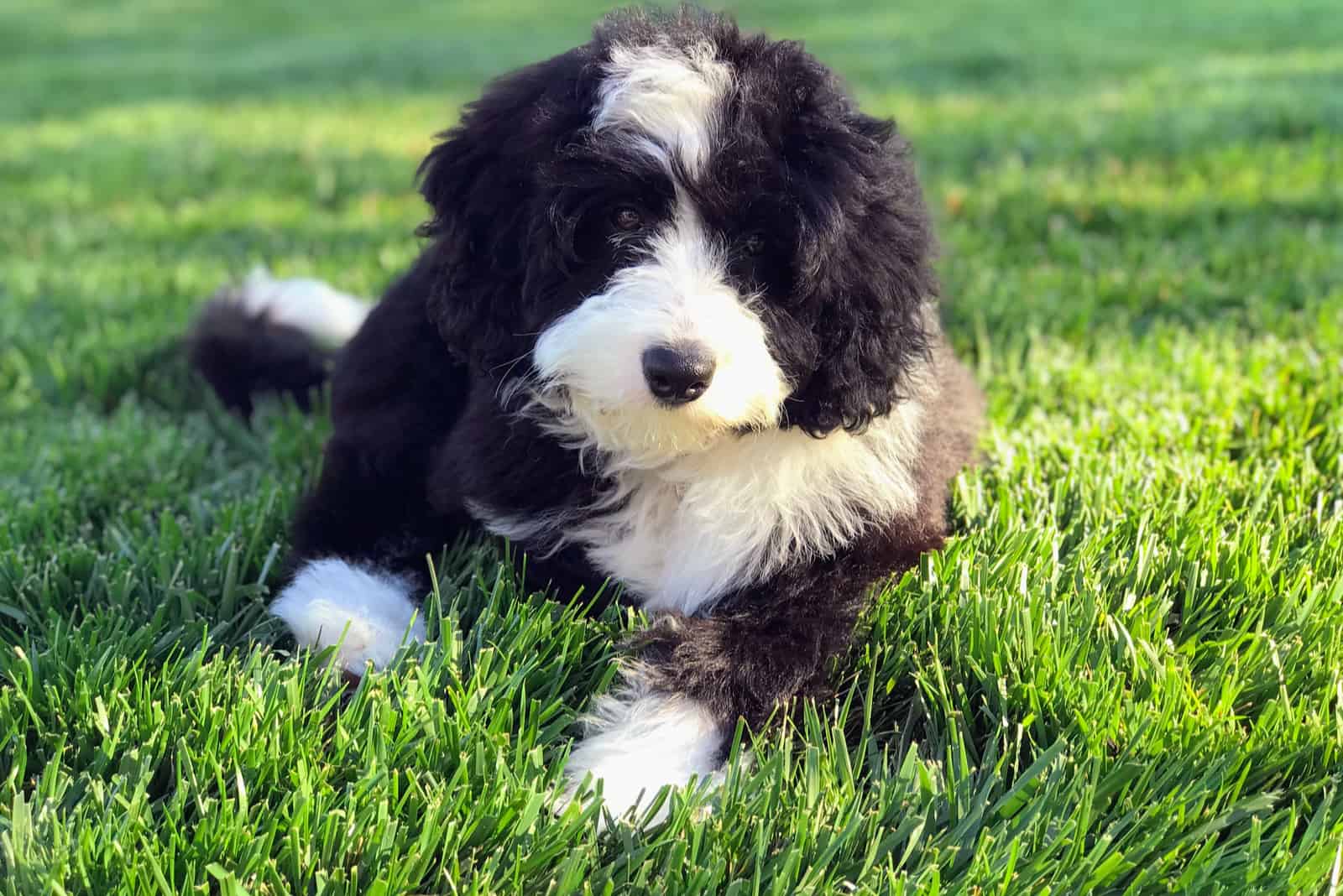
Many different breeds are prone to color fading, some more than others. There are many reasons why a dog’s coat may fade, often due to exposure to strong sunlight, disease, age, stress, or malnutrition.
The Bernedoodle has an increased risk of fading because Poodles often carry the gene that causes this. There’s a good chance that your black puppy will fade to a silver or gray color, while brown (or chocolate) tends to become beige.
Again, it would help if you spoke to your breeder about this, as they can guide you on the matter. A good breeder will know if their dogs have the fading gene, and they may offer to test their dog’s DNA for this.
The best way to get a pup that keeps its color is to find a breeder that has bred using Poodles with a non-fading lineage. Even so, there are no guarantees!
Of all the Bernedoodle colors, sable is the most likely to fade (known as clearing), and as the pup develops, its coat will become much lighter. Any dark hairs around the ears may stay the same, but the black tips will eventually grow out completely.
It’s only natural to want your pup to keep that stunning coat color, but it’s a good idea to prepare yourself for the possibility that it will fade over the next year or so. The good news is that this won’t change the dog’s affectionate, friendly, goofy personality!
Bernedoodle Coat Types
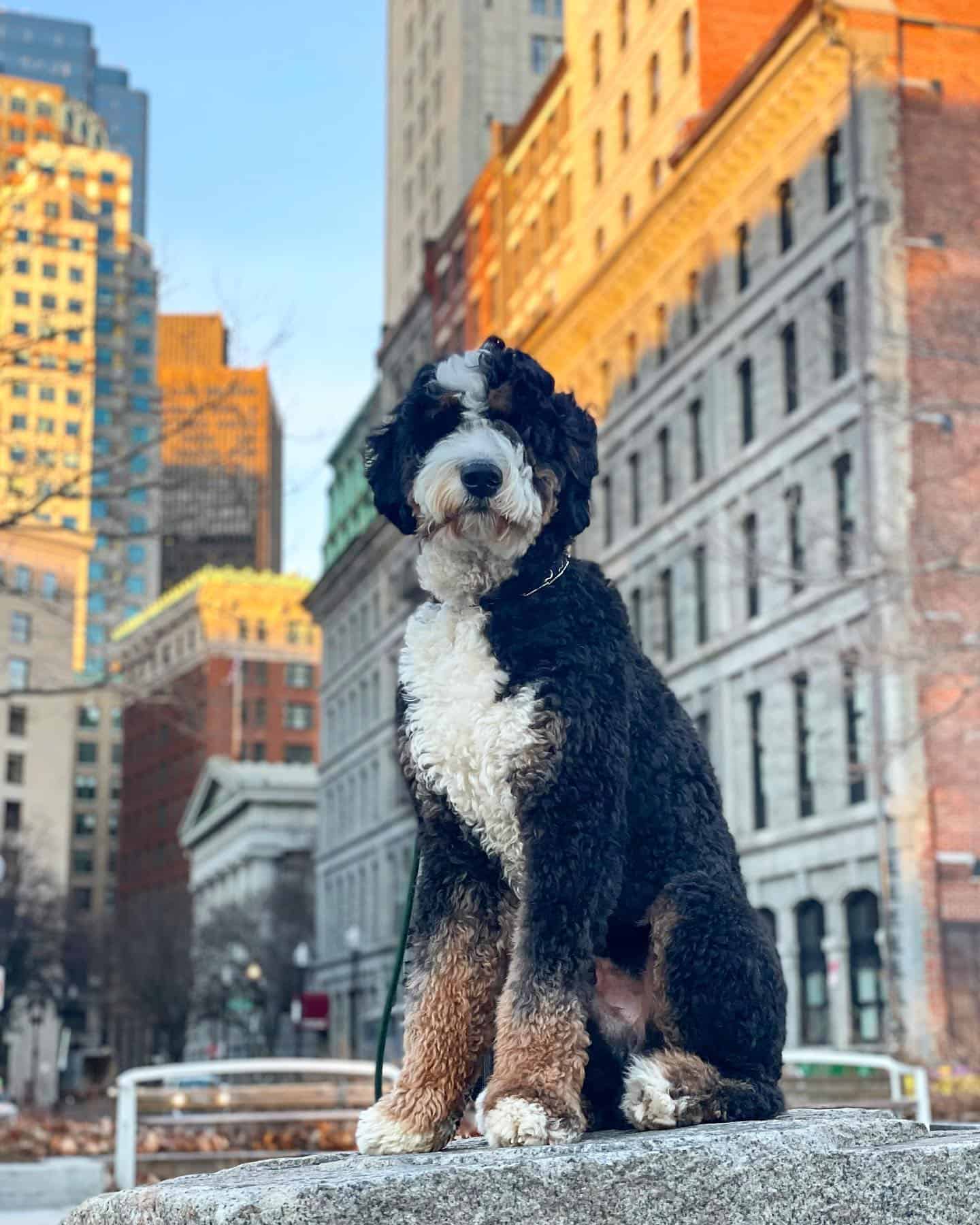
Photo from: @georgethebernedood
Your Bernedoodle will have one of three coat types: curly, straight, or wavy. The wavy coat is by far the most common.
This dog has a low-shedding coat with the hypoallergenic properties of the Poodle parent. That’s great news for allergy sufferers, and you won’t need to spend too much time vacuuming dog hair from around the home!
Even so, you will have to invest more time in grooming.
Ideally, you should brush your Bernedoodle two or three times a week. Although they don’t shed as much as some other breeds, loose hairs can become trapped in their coat, along with dirt and debris. This can all be easily brushed out, along with any tangles, as long as it is done regularly.
It’s also advisable to get your dog professionally groomed every six to eight weeks. Their hair (they don’t have fur!) grows and will need to be clipped to keep it neat and under control. For dogs with curly coats, there’s a range of cute styles that will make your pup even more adorable.
A professional groomer will wash your dog, trim its coat, check inside and clean the ears, and trim its toenails. While many dog owners feel capable of doing this themselves, it’s always a good idea to get it done professionally once in a while.
See Also: Bernedoodle Vs Sheepadoodle: Which Is The Better Dog Breed
What Is The Rarest Color Bernedoodle?
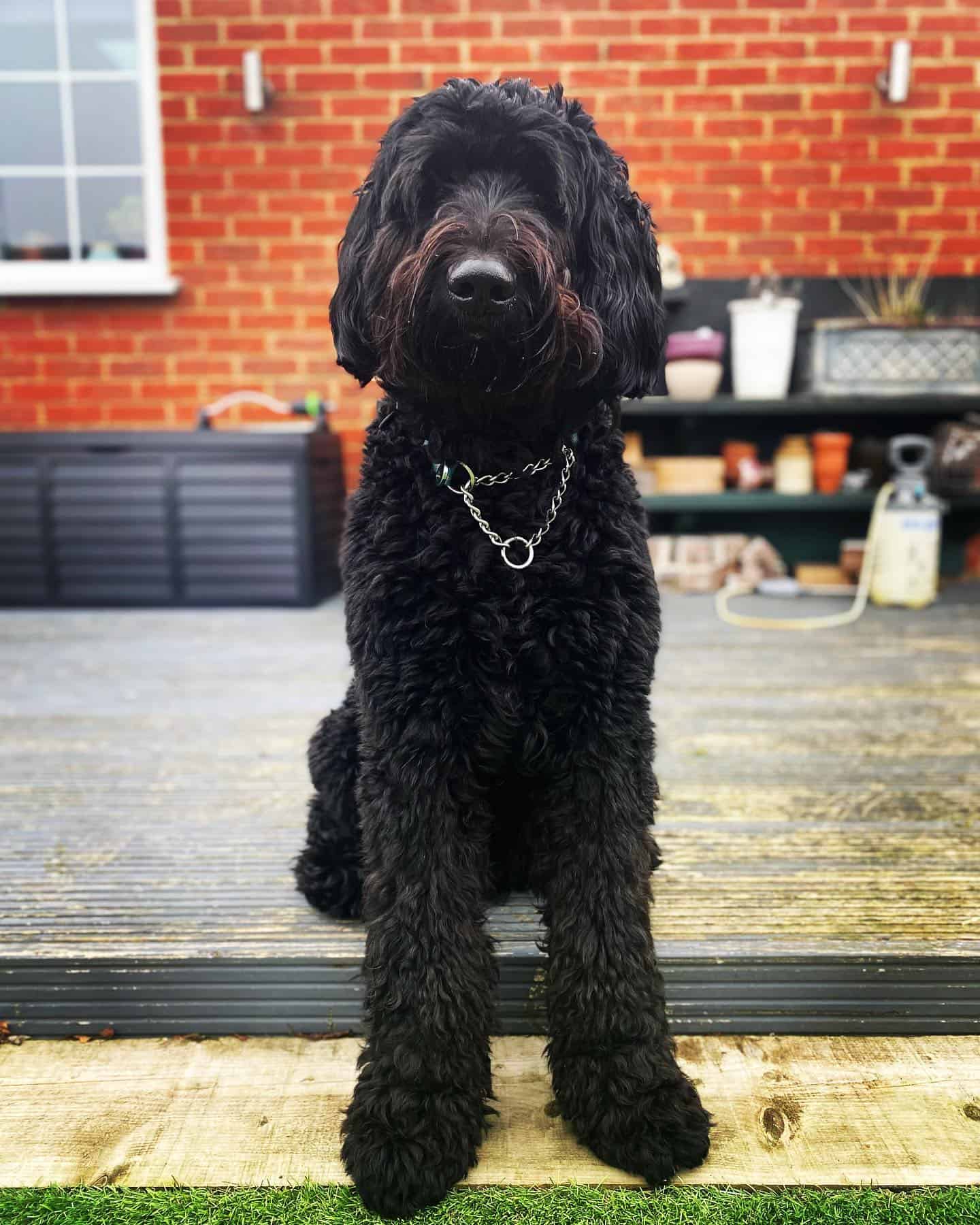
Photo from: @cookies4
Considering the wide range of fascinating Bernedoodle colors, you might be surprised to learn that solid black is probably the rarest coat color in these dogs!
The reason for this is that recessive genes produce solid colors, and they only affect the pup’s coat color if both parent dogs possess this gene and pass them on to their offspring.
Merle Bernedoodles are also quite rare, although they are becoming increasingly popular. However, this raises some ethical questions. First, the merle pattern is not part of the purebred Bernese Mountain Dog or the Poodle’s colors. The most likely explanation is that one of the parents (probably the Poodle) wasn’t purebred.
Also, the merle gene is known to cause health problems, and we’ll look into this in the next section.
Black and white bi-colored Bernedoodles are relatively rare, as are phantoms and sables.
It’s also unusual to see a solid white Bernedoodle. Although it will be classed as solid white, there’s a good chance that it may have a few black spots, especially around its neck area.
Strangely, although these colors are rare, you might be able to get one sooner than you would a tri-color Bernedoodle! That’s because these are in high demand, so you may have to wait until there’s one available.
What Is A Merle Bernedoodle?
The merle Bernedoodle has a speckled coat over a solid base color. It usually has a brown or black base with lighter flecks of blue or red over the whole coat.
Whatever color you get, it’s a stunning combination!
We’ve talked about the merle pattern quite a lot, but perhaps we should make sure that you know exactly what this means.
The merle pattern isn’t present in all dog breeds and is caused by a recessive gene. It can affect any type of coat, including sable and brindle.
The best way to describe it is a mottled, patchwork effect where blocks of solid color have been diluted by the merle gene.
Many of these dogs have blue eyes, and sometimes will have one blue eye and one brown!
As we mentioned, the merle gene is not naturally present in the Poodle breed or the Bernese Mountain Dog, so it must have entered the Bernedoodle bloodline from outside these breeds.
While it’s possible for a merle dog to be healthy, this relies on responsible and ethical breeders. You can read more about the potential health issues related to the merle gene further down.
As the merle Bernedoodles’ popularity increases, so does the risk of unethical breeders cashing in. Some breeders charge more for these dogs, simply because demand is high. Think twice before you buy from anyone who sets a high price tag on merle pups!
If the merle dog appeals to you and you’re considering getting one, it is essential that you pick a responsible, ethical breeder.
Bernedoodle Eye Problems
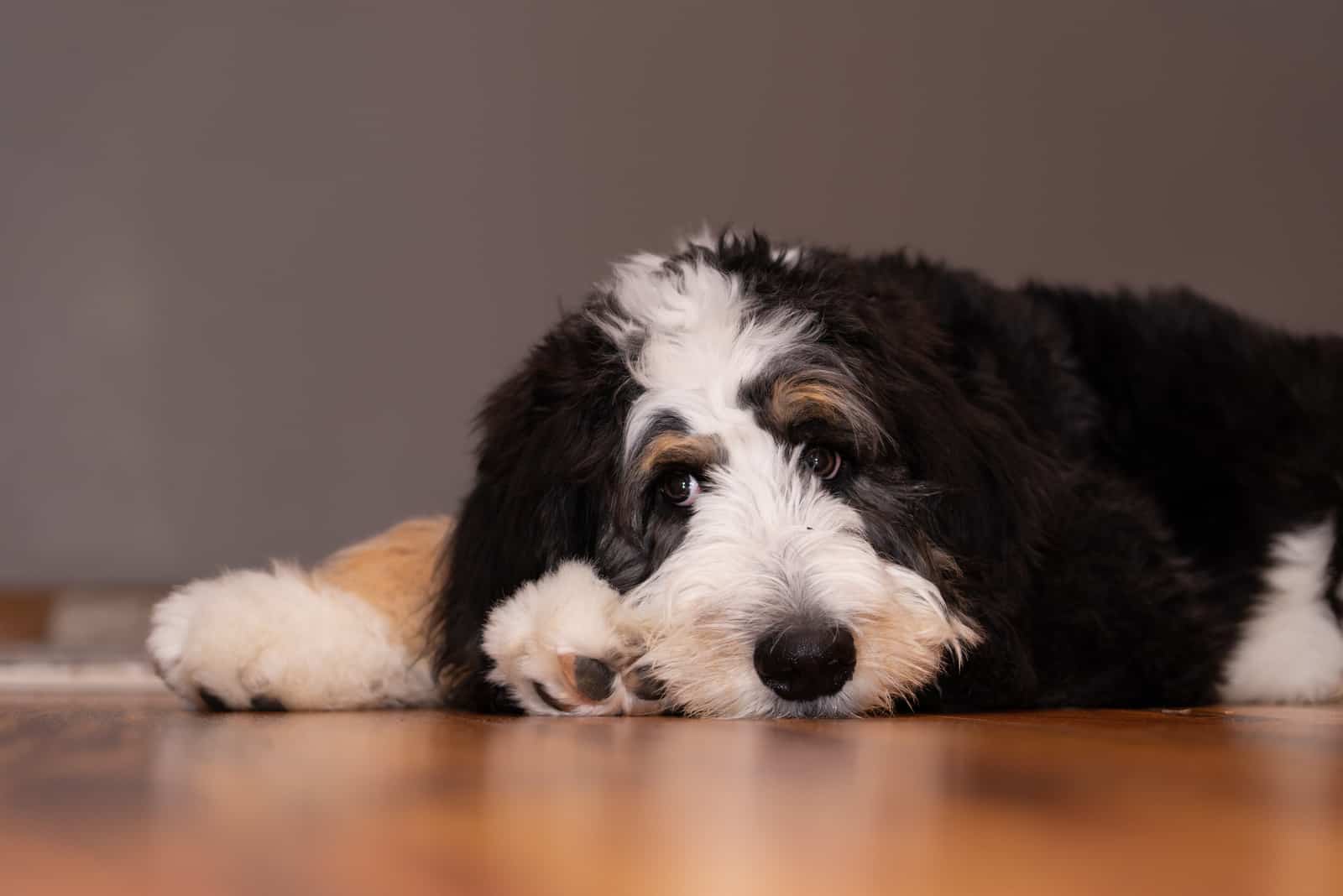
The Bernese Mountain Dog and the Poodle are prone to progressive retinal atrophy, a group of genetic eye conditions that eventually lead to complete loss of sight.
As a result, the Bernedoodle is at high risk of PRA, so you should always ask the breeder whether they test for this. A reputable breeder always runs a health screening program to ensure that their pups are as healthy as possible.
The first sign of PRA is a deterioration in your dog’s night vision. They may become disoriented at night or in low light conditions and bump into any obstacles.
The symptoms will worsen over time, and the dog will become blind. There is no cure for PRA at present, and dogs with this condition are usually prepared for life without sight.
Genetic testing of breeding dogs is the best way to tackle PRA at present.
In addition, we should mention the potential dangers of the merle gene.
The merle gene is a genetic modifier responsible for the unusual, randomly mottled, and marbled coat pattern in various breeds, including Australian Shepherds, Labradoodles, Cardigan Welsh Corgis, Border Collies, and Bernedoodles.
The trouble with this gene is that it also affects the structure and color of the eyes and the skin and pigment inside the ears. Dogs that inherit one merle gene from the parent dogs are just as healthy as any normal dog. However, if both parents carry this gene, there is a chance of a ‘double merle’ pup.
This is terrible news, as double merles can suffer from severe eye and ear problems. They are often also at a high risk for various types of cancer, including skin cancers.
Merle Color Issues
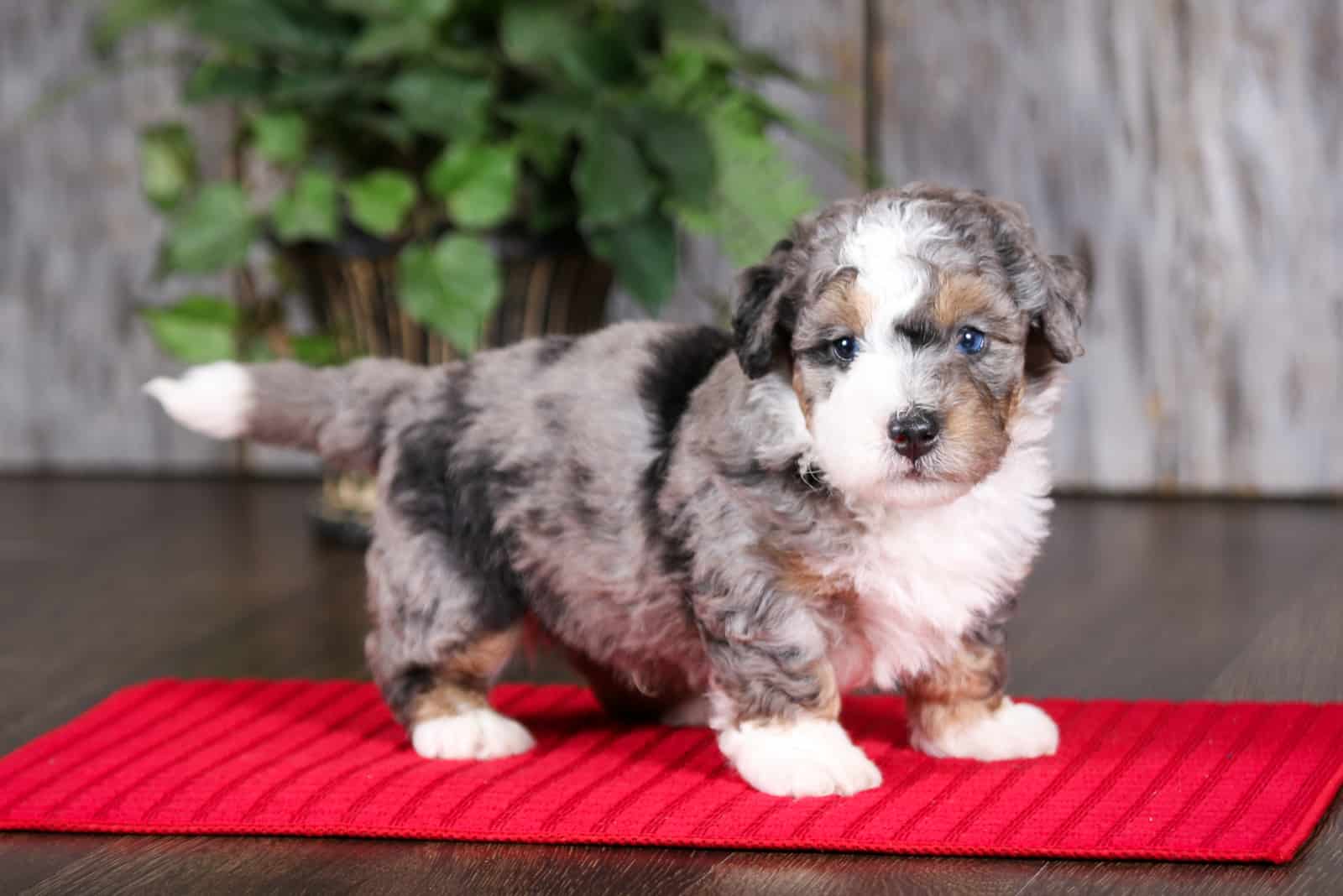
To drive the point home, you need to be careful about dogs with the merle pattern coat. Most dogs that carry a single copy of the merle gene live normal, happy, healthy lives.
Those with two copies of the gene can sometimes escape health problems if they’re lucky. However, there’s a strong chance that a double merle dog will have severe eye problems. It may be born blind or lose its eyesight at some stage.
Some are born with eyeballs that are too small to be viable, and these have to be surgically removed. Others suffer from a hearing deficiency or are profoundly deaf from birth.
Although these dogs require special care and a lot of love, it’s a big responsibility to take on, both emotionally and financially. All good breeders will avoid breeding double merles, though some will knowingly use a single merle, having thoroughly checked the breeding partner to make sure it is clear.
This highlights the fact that it’s vitally important to choose a reputable breeder!
AKC Bernedoodle Registration
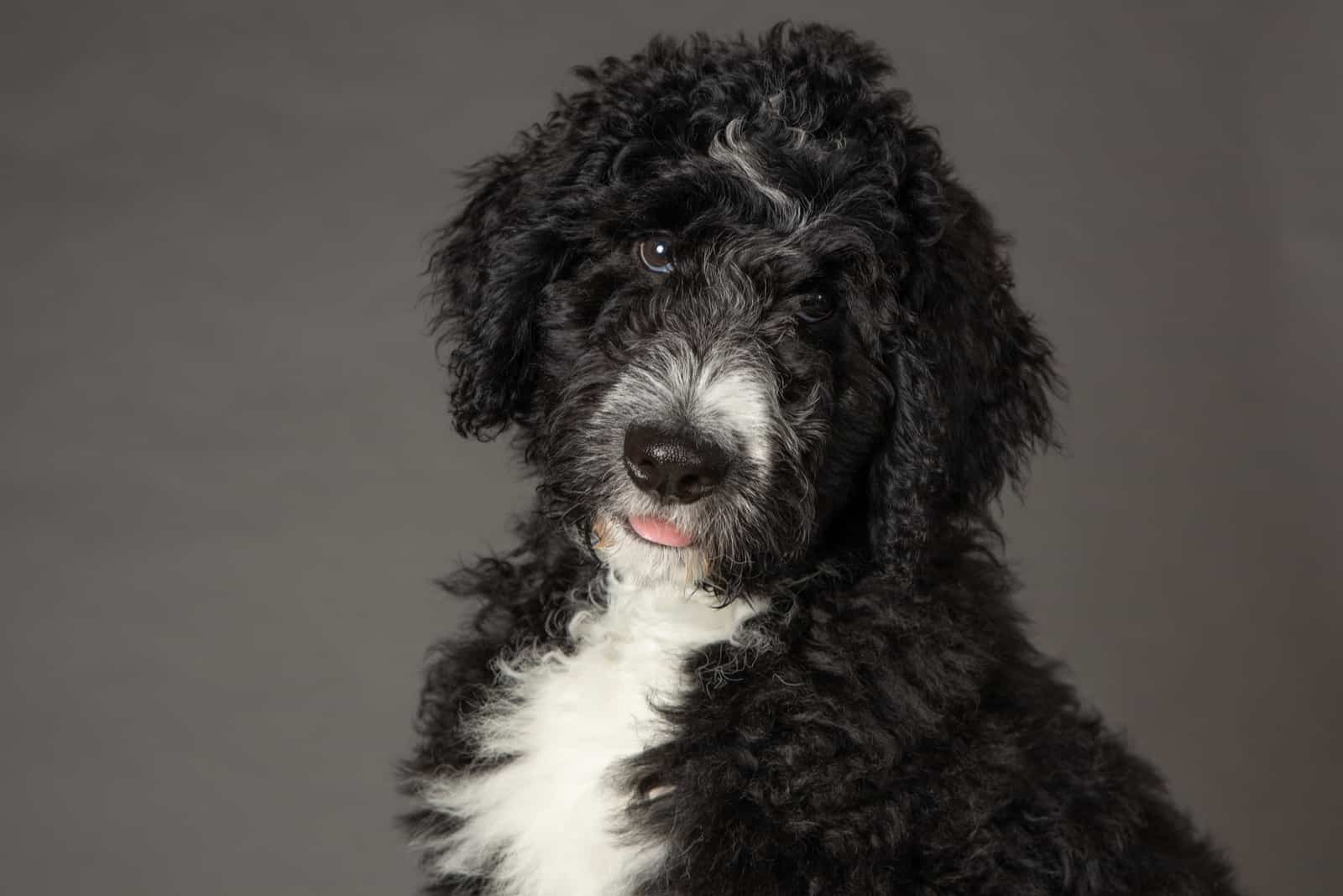
Before we finish, we should talk about the AKC and Bernedoodle registration. As noted above, the AKC doesn’t accept mixed breeds, only purebred dogs. This seems odd, as every dog we know today was a mixed breed at some time!
However, the AKC only allows breeds to be registered if parent breed clubs campaign over several years for this to happen.
As it happens, some Bernedoodle breeders have been doing just this to have the breed recognized by the AKC. On the other hand, many others don’t want this to happen as specific breed standards will bind them.
Also, the AKC has come under heavy criticism for endorsing cruel practices such as tail docking and ear cropping. In addition, they have been accused of keeping breed standards that contribute to suffering purely for the sake of conformation.
For example, the Pug suffers many health problems because of its flat face, including eye injuries and breathing difficulties. The German Shepherd is prone to hip dysplasia because of its sloping back.
Any dog with multiple folds of skin around the face is likely to get skin infections. King Charles Spaniel is at risk of brain deformity because of the shape of its skull. These are just a handful of examples.
None of these features are natural, and all of them have been selectively bred into certain breeds because humans like how it looks.
Those against the Bernedoodle being registered with the AKC prefer to continue the way they are, breeding healthy pups without restrictions and interference.
Those in favor point out that registration is a good thing, as AKC members are bound by a code of ethics, allowing customers to choose wisely.
The Last Word

We’ve covered Bernedoodle colors and a whole lot more!
As you know by now, choosing your pup’s color isn’t just a simple matter of picking what you like. Breeders will have some idea about what colors to expect in each litter, but there’s no foolproof way of knowing exactly what colors will turn up.
Unless you’re prepared to be flexible, you may be in for a long wait. The best breeders only produce one or two litters each year, so if a pup of your preferred color doesn’t show up, you might have to wait another year.
Then there’s the issue of coat color fading. Most pups change color as they grow, and there isn’t much you can do about it. Bernerdoodles that inherit the Poodle’s fading gene have an increased risk of clearing. Your dog’s coat will probably become much lighter within two or three years.
Again, there isn’t anything you can do except consulting with your breeder to see what advice they can offer. The best approach is to focus on your pup’s amazing character and personality. It has bags of love to give and will be loyal to the end, so who cares if its coat changes color?
While you can’t really pick one single breed out as the perfect dog (most dog owners would say that they already have one!), it’s fair to say that the Bernedoodle comes pretty close. It’s a big furry ball of love that will always be loyal and will shower you with affection at every opportunity. It gets on well with other dogs, greets strangers like old friends, and absolutely loves kids.
If that wasn’t enough, the Bernedoodle is easy to train and won’t affect people with mild allergies.
If you can get the color you want, that’s great. But when you’ve got a dog with all of those other excellent qualities, its color isn’t really that big of a deal. All Bernedoodles make amazing family pets that you will love for years to come.
Read Next:
• 9 Bernedoodle Breeders In Texas: Lone Star State Doodles
• Top 8 Trustworthy Bernedoodle Breeders In Illinois















